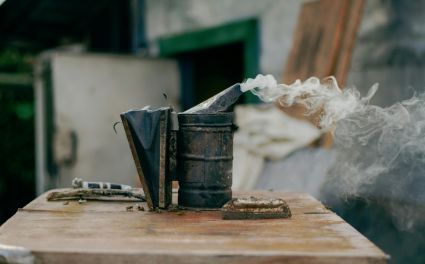Bee pollen is one of nature’s most nutrient-rich superfoods — packed with proteins, vitamins, minerals, and enzymes. It plays a vital role in plant pollination and serves as an essential food source for bees themselves. But have you ever wondered how this golden treasure is collected and processed — both by bees and beekeepers?
In this detailed guide, we’ll explore the entire journey of bee pollen harvesting, from the tireless work of worker bees in the field to the careful processing handled by professional beekeepers. Along the way, we’ll highlight how modern beekeeping equipment and protective clothing — like beekeeping suits and beekeeping gloves — make this task safer and more efficient.
🐝 Bee Pollen Collection by Bees
Worker Bees as Pollinators
The entire process begins with the worker bees — nature’s tireless pollinators. These female bees venture from flower to flower in search of nectar. In doing so, they accidentally gather pollen grains on their hairy bodies and legs. As they move between flowers, they transfer pollen, enabling fertilization — a process essential for the growth of fruits, seeds, and the continuation of plant species.
This incredible act of pollination is one of the reasons honey bees are so crucial to ecosystems worldwide. Learning about this process is a big part of Learn Beekeeping programs and workshops offered by many experienced apiarists.
Gathering and Packing Pollen
Bees collect pollen using their mouthparts and legs, scraping grains from flower anthers. They then mix this pollen with nectar and a bit of saliva to form small, sticky granules. These are stored in special sacs on their hind legs called pollen baskets, or corbiculae.
Once the bee returns to the hive, it stores the pollen in honeycomb cells — providing a protein-rich food source for young larvae. For any beekeeper observing this cycle, protective wear like beekeeping jackets and beekeeping veils is essential to stay sting-free while handling or observing bee activity.

🍯 Bee Pollen Harvesting by Beekeepers
Collecting Pollen with Traps
Beekeepers harvest bee pollen using specially designed pollen traps. These are fitted at the hive entrance, gently brushing off pollen pellets from returning bees. Timing is key — pollen traps are usually installed when floral sources are abundant, and the colony’s needs are already met.
During harvesting, beekeepers wear full-body beekeeping suits with ankle protection and beekeeping gloves for comfort and safety. Even a pink bee suit like these adds style while keeping the beekeeper protected.
Placement and Timing
Proper placement ensures that traps don’t stress the bees or disrupt nectar collection. Most beekeeping professionals use pollen traps sparingly, often rotating their use between hives to maintain colony strength. With adequate care and timing, pollen harvesting can be both sustainable and productive.
Methods of Extraction
Once traps are full, the collected pollen is carefully removed. Screens or vibrating devices are used to separate debris. During this process, beekeepers rely heavily on durable beekeeping trousers and veils for added comfort and protection — especially during the busy spring season when bees are most active.
For those new to the field, Learn Beekeeping guides and resources (like this one) can help master these safe and sustainable techniques.
⚙️ Processing Bee Pollen
Cleaning and Drying
After harvesting, the pollen goes through a cleaning process to remove dust, wings, or small debris. Mesh screens with various pore sizes are used to ensure purity.
Once cleaned, drying is crucial to prevent spoilage. Many professional operations prefer freeze-drying, which retains nutrients better than air-drying. After drying, pollen is stored in airtight containers away from light and moisture to maintain freshness.
Packaging and Commercial Use
Commercial bee pollen is sold in granule, capsule, or powder form. Each batch is labeled with origin and nutritional content, much like honey and royal jelly products.
For professionals handling large-scale pollen production, reliable beekeeping equipments like these tools ensures efficiency and safety.
If you’re managing hives, always wear the right protective gear — beekeeping jackets,beekeeping gloves, and veils — to stay comfortable during long working hours.
🌿 Nutritional and Health Benefits of Bee Pollen
Bee pollen is often called “nature’s multivitamin.” It contains a wide range of B vitamins, vitamin C, E, calcium, magnesium, amino acids, and antioxidants. Its high protein content makes it an excellent energy booster for both humans and bees.
Culinary Uses
Bee pollen adds a sweet, floral flavor and vibrant color to food. It’s used in smoothies, yogurts, salads, or sprinkled over cereal. It can even be mixed with honey for a natural energy shot — something every beekeeper appreciates after a long day of hive maintenance.
Health & Wellness
Many people use bee pollen to boost immunity, improve digestion, and support overall wellness. It’s believed to reduce seasonal allergies and promote glowing skin. However, those with pollen allergies should consult a doctor before consumption.
To explore more health-related bee facts, visit the Lives of Bees blog, or learn how bee colonies operate through Learn Beekeeping.
🐝 Beekeeping Safety and Bee Behavior
Beekeeping involves regular interaction with honey bees, bumblebees, and sometimes even carpenter bees. Understanding their behavior helps prevent stings and ensures safety.
Check out these educational reads:
Beekeepers often ask, “Do bee suits protect from wasps?” Absolutely — high-quality beekeeping suits with multi-layer mesh designs offer reliable protection against wasp and bee stings alike. Learn more in The Stinging Truth: Bee Suits in Wasp Defense.
And if you ever get stung, here’s how to safely remove a bee sting without harming your skin.

🧰 Tools, Suits, and Equipment for Beekeepers
Modern beekeeping equipment makes hive management safer and more efficient. Essential tools include smokers, hive tools, and frame grips — all available in collections like Tools & Accessories.
When working around active hives, wearing a full beekeeping suit is crucial, complemented by:
-
Beekeeping Gloves
-
Beekeeping Veils
These protective pieces, used by professionals worldwide, help beekeepers stay comfortable and confident during hive inspections or pollen collection.
🌼 Conclusion
From the delicate work of honey bees gathering pollen to the precise methods of beekeepers harvesting it, every step of this process demonstrates harmony between nature and human care.
Bee pollen is more than just a byproduct of the hive — it’s a symbol of the bees’ incredible labor and a reminder of why sustainable beekeeping matters. Whether you’re learning to distinguish a bee hive from a wasp nest or exploring how bees collect honey, understanding these tiny creatures helps us appreciate their immense contribution to our world.
For more guides, visit Read More Blogs About Beekeeping and continue your journey into the art and science of beekeeping.




